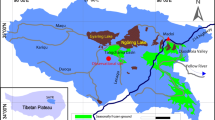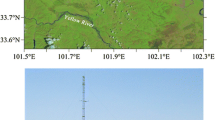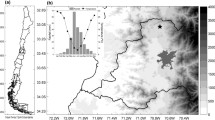Abstract
Knowledge of seasonal variation of net ecosystem CO2 exchange (NEE) and its biotic and abiotic controllers will further our understanding of carbon cycling process, mechanism and large-scale modelling. Eddy covariance technique was used to measure NEE, biotic and abiotic factors for nearly 3 years in the hinterland alpine steppe—Korbresia meadow grassland on the Tibetan Plateau, the present highest fluxnet station in the world. The main objectives are to investigate dynamics of NEE and its components and to determine the major controlling factors. Maximum carbon assimilation took place in August and maximum carbon loss occurred in November. In June, rainfall amount due to monsoon climate played a great role in grass greening and consequently influenced interannual variation of ecosystem carbon gain. From July through September, monthly NEE presented net carbon assimilation. In other months, ecosystem exhibited carbon loss. In growing season, daytime NEE was mainly controlled by photosynthetically active radiation (PAR). In addition, leaf area index (LAI) interacted with PAR and together modulated NEE rates. Ecosystem respiration was controlled mainly by soil temperature and simultaneously by soil moisture. Q 10 was negatively correlated with soil temperature but positively correlated with soil moisture. Large daily range of air temperature is not necessary to enhance carbon gain. Standard respiration rate at referenced 10°C (R 10) was positively correlated with soil moisture, soil temperature, LAI and aboveground biomass. Rainfall patterns in growing season markedly influenced soil moisture and therefore soil moisture controlled seasonal change of ecosystem respiration. Pulse rainfall in the beginning and at the end of growing season induced great ecosystem respiration and consequently a great amount of carbon was lost. Short growing season and relative low temperature restrained alpine grass vegetation development. The results suggested that LAI be usually in a low level and carbon uptake be relatively low. Rainfall patterns in the growing season and pulse rainfall in the beginning and at end of growing season control ecosystem respiration and consequently influence carbon balance of ecosystem.
Similar content being viewed by others
References
Adams J M, Faure H, Faure-Denard L, et al. Increases in terrestrial carbon storage from the Last Glacial Maximum to the present. Nature, 1990, 348: 711–714
Kato T, Tang Y H, Gum S, et al. Carbon dioxide exchange between the atmosphere and an alpine meadow ecosystem on the Qinghai-Tibetan Plateau, China. Agric For Meteorol, 2004, 124: 121–134
Flanagan L B, Johnson B G. Interacting effects of temperature, soil moisture and plant biomass production on ecosystem respiration in a northern temperate grassland. Agric For Meteorol, 2005, 130: 237–253
Xu L K, Baldocchi D D. Seasonal variation in carbon dioxide exchange over a Mediterranean annual grassland in California. Agric For Meteorol, 2004, 1232:79–96
Xu L L, Zhang X Z, Shi P L, et al. Establishment of apparent quantum yield and maximum ecosystem assimilation on Tibetan Plateau alpine meadow ecosystem. Sci China Ser D-Earth Sci, 2005, 48(Supp.I): 141–147
Lloyd J, Taylor J A. On the temperature dependence of soil respiration. Funct Ecol, 1994, 8: 315–323
Fang C, Moncrieff J B. The dependence of soil CO2 efflux on temperature. Soil Biol Biochem, 2001, 33: 155–165
Zhang X Z, Shi P L, Liu Y F, et al. Experimental study on soil CO2 emission in the alpine grassland ecosystem on Tibetan Plateau. Sci China Ser D-Earth Sci, 2005, 48(Supp.I): 218–224
Xu M, Qi Y. Spatial and seasonal variations of Q 10 determined by soil respiration measurements at a Sierra Nevadan forest. Glob Biogeochem Cycle, 2001, 15: 687–696
Craine J W, Wedin D A, Chapin F S, et al. Predominance of ecophysiological controls on soil CO2 flux in a Minnesota grassland. Plant Soil, 1999, 207: 77–86
Janssens I A, Lankreijer H, Matteucci G, et al. Productivity over-shadows temperature in determining soil and ecosystem respiration across European forests. Glob Change Biol, 2001, 7: 269–278
Griffis T J, Black A, Gaumont-Guaya D, et al. Seasonal variation and partitioning of ecosystem respiration in a southern boreal aspen forest. Agric For Meteorol, 2004, 125: 207–223
Desai A R, Bolstad P V, Cook B D. Comparing net ecosystem exchange of carbon dioxide between an old-growth and mature forest in the upper Midwest, USA. Agric For Meteorol, 2005, 128: 33–55
Land Management Bureau of Tibet Autonomous Region, Animal Husbandry Bureau of Tibet Autonomous Region. Rangeland resources in Tibet Autonomous Region (in Chinese). Bei**g: Science Press, 1994
Li W H, Zhou X M. Ecosystem of Qinghai-**zang (Tibet) and Their Sustainable Management Models (in Chinese). Guangzhou: Guangdong Science and Technology Press, 1998
Comprehensive Scientific Expedition to the Qinghai-**zang (Tibet) Plateau, Chinese Academy of Sciences. Climate of **zang (Tibet) (in Chinese). Bei**g: Science Press, 1984
Comprehensive Scientific Expedition to the Qinghai-**zang (Tibet) Plateau, Chinese Academy of Sciences. Vegetation of **zang (Tibet) (in Chinese). Bei**g: Science Press, 1988
Dong M. Observation and Analysis of Terrestrial Biome (in Chinese). Bei**g: Standards Press of China, 1996
Webb E K, Pearman G I, Leuning R. Correction of flux measurements for density effects due to hear and water vapor transfer. Q J R Meteorol Soc, 1980, 106: 85–100
Yu G R, Wen X F, Li Q K, et al. Seasonal patterns and environ-mental control of ecosystem respiration in subtropical and temperate forest in China. Sci China Ser D-Earth Sci, 2004, 48(Supp I): 93–105
Falge E, Baldocchi D D, Olson R J, et al. Gap filling strategies for defensible annual sums of net ecosystems exchange. Agric For Meteorol, 2001, 107: 43–69
Gu S, Tang Y H, Du M Y, et al. Short-term variation of CO2 flux in relation to environmental controls in an alpine meadow on the Qinghai-Tibetan Plateau. J Geophys Res, 2004, 108: 4670–4679
Xu S X, Zhao X Q, Fu Y L, et al. Characterizing CO2 fluxes for growing and non-growing seasons in a shrub ecosystem on the Qinghai-Tibet Plateau. Sci China Ser D-Earth Sci, 2004, 48(Supp I): 133–140
Ham J M, Knapp A K. Fluxes of CO2, water vapor, and energy from a prairie ecosystem during the seasonal transition from carbon sink to carbon source. Agric For Meteorol, 1998, 89: 1–14
Dugas W, Heuer M L, Mayeux H S. Carbon dioxide fluxes over bermudagrass, native prairie, and sorghum. Agric For Meteorol, 1999, 93: 121–139
Kim J, Verma S B. Carbon dioxide exchange in a temperate grassland ecosystem. Bound Layer Meteor, 1990, 52: 135–149
Verma S B, Kim J, Clement R J. Momentum, water vapor, and carbon dioxide exchange at a centrally located prairie site during FIFE. J Geophys Res, 1992, 97: 18629–18639
Valentini R, Gamon J A, Field C B. Ecosystem gas exchange in a California grassland: seasonal patterns and implications for scaling. Ecology, 1995, 76: 1940–1952
Hunt J E, Kelliher F M, McSeveny T M, et al. Evaporation and carbon dioxide exchange between the atmosphere and a tussock grassland during a summer drought. Agric For Meteorol, 2002, 111: 65–82
Raich J W, Schlesinger W H. The global carbon dioxide flux in soil respiration and its relationship to vegetation and climate. Tellus, 1992, 44B: 81–99
Tjoelker M G, Oleksyn J, Reich P B. Modeling respiration of vegetation: evidence for a general temperature-dependent Q 10. Glob Change Biol, 2001, 7: 223–230
Author information
Authors and Affiliations
Corresponding author
Rights and permissions
About this article
Cite this article
Shi, P., Sun, X., Xu, L. et al. Net ecosystem CO2 exchange and controlling factors in a steppe—Kobresia meadow on the Tibetan Plateau. SCI CHINA SER D 49 (Suppl 2), 207–218 (2006). https://doi.org/10.1007/s11430-006-8207-4
Received:
Accepted:
Issue Date:
DOI: https://doi.org/10.1007/s11430-006-8207-4




